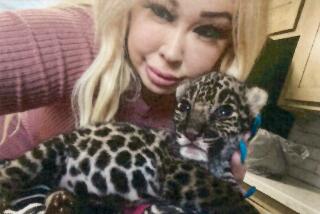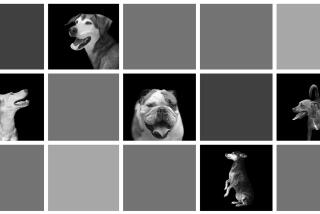Wildcare Inc.: Hospital for Ailing Animals
- Share via
DeSOTO, Kan. — For a great blue heron and a bobcat, for a steely-eyed bald eagle and a shivering baby coyote--Wildcare Inc. is home for now.
The fervent desire of the 70 or so humans who put hundreds of volunteer hours into nursing the injured animals is that it be home for as short a time as possible.
The bobcat was released back into the wild one week in July--a victory for Wildcare director Nancy Schwarting and manager Anne Deegan-Chandler. Earlier this year, several bald eagles were released.
The most important thing is to not become emotionally attached to an injured wild animal, they say. Nurse it back to health and get it back into its natural habitat as soon as possible.
“You do get a twinge,” Deegan-Chandler said. “But I get relieved when we release them. They are in cages. That is not where they are supposed to be. They know it. You know it.”
Wildcare, about 12 years old now, was formed to care for the victims of man’s ever increasing expansion and the resulting encroachment on life in the wild.
Wild animals get run over by cars or shot at or crash into power lines. All are injuries Wildcare tries to mend.
Here is the perspective of Wildcare: The bird did not fly into a power line; the power line hit the bird.
“We need to look at them as neighbors,” Schwarting said. “Or as refugees. We have to learn to live with them.”
Wildcare began in the Animal Care Unit at the University of Kansas, the department responsible for caring for laboratory animals.
With the Animal Care Unit cramped for space, Wildcare is moving to university-owned land east of Lawrence. The university is leasing the land for $1 a year.
Behind the white frame house, animals under care now are housed in makeshift outbuildings donated by KPL Gas Service. Wildcare is anxiously awaiting completion of a new building donated by two Lawrence individuals, John Chaney, a contractor, and Scott Roberts, a plumber.
Deegan-Chandler, a biologist who has worked in zoos in Houston and Topeka, lives with her husband in the house on the land and spends her time coordinating the comings and goings of the volunteers and managing the paperwork required for working with endangered species. She does not get paid and works in exchange for the housing.
Schwarting is a veterinarian technician.
“I like (the work) better than the zoos because of the new emphasis on education,” Deegan-Chandler said. “We take and we take and we take from the Earth. If we can give something back, that’s important. That’s why the focus is on public education. I’m really interested in education. I’d really like to be out of a job.”
Wildcare treated about 1,000 animals last year and strives to release about 50% of them.
Not all of the animals brought to Wildcare recover sufficiently to be released, a decision Schwarting always hates to make. Some are placed with zoos and others are kept to help in educational programs. Some also are kept to be used as foster parents when baby animals are brought in.
“Here is a baby turkey vulture that is a perfect example of not having a foster parent,” Schwarting said. “He doesn’t use his claws, he doesn’t bite, he isn’t defensive. He’s a failure, we think, or he wouldn’t stand here like this. He can’t be released and we’d 10 times rather release them than place them.”
Critics, including a former director who resigned last August, contend the release percentage has gone down in recent years. Christy Kennedy, a director for 10 years, also said the deaths of two animals--a great horned owl and a bobcat--also raise questions about the care.
Schwarting said the owl’s death was being investigated. The bobcat had to be put to sleep after it chewed one of its legs to the bone.
Others question whether Wildcare will be able to continue financially after ending its association with the University of Kansas.
“Next month will be the big test,” Schwarting said.
Wildcare will try to raise about $25,000 for the coming year, most of it from corporate sources, she said. About a dozen veterinarians donates services, but Wildcare will have to pay for utilities, food and medical supplies for the first time.
If it succeeds, Wildcare will become part of a growing number of organizations that believe injured animals must be rehabilitated and released.
“Rehab as a field is new,” Schwarting said. “The problem is the membership is not high. A lot of states are working with backyard rehabs.
“The fundamental ethics on release is don’t keep them in cages. It’s not humane.”
More to Read
Inside the business of entertainment
The Wide Shot brings you news, analysis and insights on everything from streaming wars to production — and what it all means for the future.
You may occasionally receive promotional content from the Los Angeles Times.










